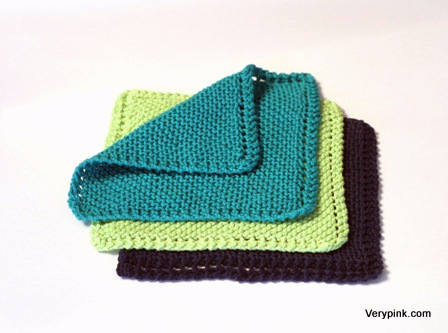
I am offering this tutorial (pattern + instructional videos) for FREE! This is a traditional pattern, not my own design, that has been used for generations. I am presenting this for beginning knitters who would like to learn this technique, and to give a free sample of my video tutorials.
For knitters, knitting a dishcloth is similar to a chef cooking a perfect egg. It is a chance to really focus on basic skills and do them well. In knitting, that means beautiful stitches, even edge tension, and tidy finishing work.
Size: any size square, mine are about 9×9”
Needles: size 7 US, straights or circulars
Yarn: about 35 grams of worsted weight cotton (65 yards)
Additional Materials: tapestry needle for weaving in ends
Gauge: really not important, but I got 4.5 stitches per inch in garter stitch
UPDATE – this pattern has been updated to include instructions for working rectangular dishcloths.
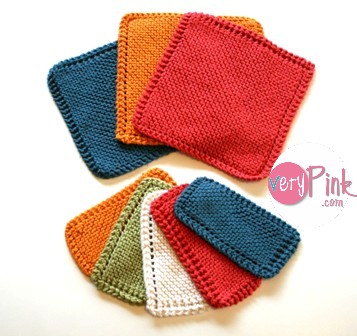
Pattern + links to instructional videos FREE Ravelry download.
Be sure to check out my other video tutorials.



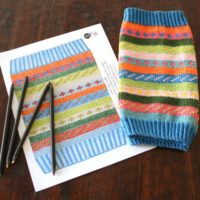
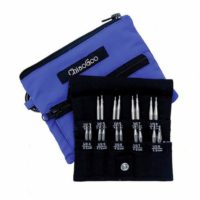
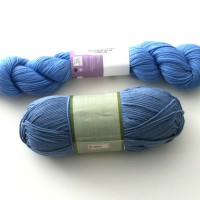
I think that’s a great idea!!! I love them.. i’ll sure make some as gifts 😀 😀
that is a great gift. love it, will try it….
Hi. I’m wondering whether the yarn to use for this project has to be 100% cotton? I have some yarns in my stash which are half cotton and half wool. Will this work too?
Hi Vikky – take a look at the washing instructions on your yarn. Is it machine washable? If so, it should work fine. You might get a little felting if you use it in really hot water, but it should be okay.
S t a c i
I’ve made quite a few of these and they are really pretty done in a varigated cotton yarn.
Great timing! I just bought some Cotlin from KnitPicks to make spa cloths. :o)
Oy, I keep forgetting my keyboard clown smiley face doesn’t work here. That’s supposed to be a 🙂
THANKS! I have so little time for knitting and this was perfect! I finished this project while sitting with my mom at DR’s office and when I got home found that my stitches had dropped off {the last 4} I tried to fix it and botched it, so now the ending edge looks crappy. I have watched your video about dropped stitches but I still made a bad job of it! Guess this one will be mine — haha.
Hi, your website and your patterns are AMAZING! Your explanations are so clear, and the quality of your videos is brilliant! I’m from Brussels, Belgium, but I swear that if I go to Austin (I actually have an uncle who lives there), i’ll come to Gauge Knits to thank you in person 🙂
Also, the comments on your toe-up sock tutorial are closed, but I wanted to share a technique that could maybe interest you (i haven’t knit any sock yet, so i can’t say if it is useful or not) http://www.knitty.com/ISSUEspring06/FEATmagiccaston.html
Hi Staci, I was wondering how do you end off the pattern? I’ve knit these before and my end “corner” never comes out looking like my beginning corner. I must be either not following the pattern long enough or to having to little stitches. I have tried a few different ways and it never seems to come out neat. Any suggestions or tips you have would be greatly appreciated.
And by the way, every time I look at one of your videos, you make me want to knit, knit, knit!
Thanks for all you do.
Julie – are you follow the pattern as written? Because getting down to four stitches, then binding them off, is the way to make the two corners match.
Are you sure you’re working the bind off properly? Just in case, here’s a video:
https://verypink.com/2010/03/13/video-binding-off/
The last thing would be blocking. Until you wash and lay the dishcloth out flat to dry, your corners probably won’t match. Like I show in the video, the decrease end will probably be long and stretched before blocking.
Hope that helps!
S t a c i
Thank you! I LOVE it that I can get busy and check back on your site and find wonderful surprises. Love you!
ann
I am so excited!! I just finished my first knitted wash cloth! Thx so much. Can’t wait to get my needles back to work.
I just love making these dishcloths. They are great TV knitting. I made a bunch of them for me, and now I’ve been giving them away to all my non-knitter friends. Staci, if you are looking for pattern ideas, I’d love for you to do a video on the classic tea cozy. Thanks so much for your website and all the help. Nancy
I love your video here …I am someone whom finds it easier to watch someone to learn to do it. But I am wondering how do you make out a pattern for a dishcloth on paper (like putting a design of animals or something on it ) do you know how to do this I am trying to find someone that can tell me how?
hi!
I learn to knit the dishcloth from your video but i don’t know how to finish. Your video just show the turn conner there’s no the finish video,so please show me the video to finish it. I’m waiting……
From Icy (Cambodia)
thanks
I was wondering how you are supposed to finish off the dish cloth.
Nevermind.. I watched the binding off video. Thanks! I have made two dishrags with the normal straight stitch and when I seen your tutorial I loved the look of the rags so I had to try it. Its fairly easy. Thanks so much
Hi, I was wondering if you ever thought of making dvd’s of your videos to sell instead of downloading them. I am interested in your Christmas stocking
Oh thank you very much Vickky. I learned from you quickly. I can’t hear you because I am deaf. I watched while you knitted at first place to end. Wow I am so happy that I know how to knit dishcloth. I made second dishcloth. I am so excite to have lots of them because it is so useful. Smile you have a nice day 🙂
Oops I thought your name was Vickky. LOL. Thank you very much Staci 🙂
Hi Stacy, thank you so much these tutorials are so good and I made two dishcloths already and I had to force my mum to use them and your tutorials are so good I almost think I am dreaming.
I’m going to make some of these for Christmas. Thanks for sharing this and your video was very helpful!
Done! Mine is not so pretty (the cotton yarn I had was a dark, muddy brown), but the texture and feel is nice. Of course there is a hole (grr) and a stitch in place of one of the yarn over holes. But I got to figure out increases and decreases and purposely make lacy holes with yarn overs, so good stuff. Thanks Staci!
Picture here: http://tinyurl.com/86beh62
Thank you so very much for this pattern & tutorial! I’ve been housebound and needed something to do. I’ve been looking for this pattern since buying a hand full in the mountains. They are wonderful and a great way to learn to knit.
I am trying to understand how you are doing this. Do you have to do the long tail cast on or can you just do the regular one? And do you want this to be really tight because when I
do it all of my yarn turns into a huge knot. I have restarted at least 30 times and really want to learn to do this so I can knit some presents. Please help!!!
Hi Olivia – I recommend the long-tail cast-on, because it’s a good sturdy cast-on for everyday use. But you can use whichever cast-on you prefer. It really makes no difference in this pattern.
No need to knit any part of this pattern tightly. Just use regular tension throughout.
Hope that helps!
S t a c i
Well I don’t understand the long tail I tried watching it but Im more of a hands on learner.
When I m done with my four regular knits then I start my two other knits. I get soo lost after that over the string thing. That’s when my yarn turns to a huge knot, not a v-shape! 🙁 I hope I get it”
I get confused on the yarn over!!!!!!
Olivia – if you need help specifically with the yarn over, this video might help:
https://verypink.com/2011/09/21/yarn-over/
S t a c i
thanks so much! i will try again! i am confident! i hope i didn’t bother you on your thanksgiving day!
God Bless!
I knit one of these dishcloths with Lion Brand Vanna’s Choice, but it turned out really think and heavy. Can you recomend a better, thinner yarn that might work better? Thanks!!!! 🙂
Hi Elisabeth – you can really use any yarn for this pattern. If you start knitting and you find that the fabric is looking stiff and heavy, you can go up a needle size (or two) to correct this. I recommend using 100% cotton yarn.
Love,love,love your site and videos. I get fired up to knit when I watch and I am making a “bucket list” of stuff I want to do in knitting before I cross over! LOL!!! One ios to “throw” like you do!!!-Thanks, so much! I send everyone to your site!-Glenda in Georgia
Staci,
Hello! My friend and I absolutely love your videos. Thank you for sharing. Would you mind to share the brand of yarn you use in this video? We shop at knit picks frequently and wondered if this might be one of their lines of cotton.
Thank you!
Hi Michelle – the yarn I used in the dishcloth video is just some leftovers from another project, and not actually ideal for dishcloths. When I go to knit more, I’ll be using this Knit Picks yarn called “Dishie” –
http://www.knitpicks.com/yarns/Dishie_Yarn__D5420207.html
🙂
S t a c i
This is such a great tutorial. Thanks so much. And you are right…..great tv knitting.
Just to tell you a big big thanks for this tutorial ! These dishclothes are fantastic ! When dry, they make my tab sparkle (without chemicals, nor water) and wipe away dust without spreading it all around. Combined with a wet dishcloth, they clean so well my windows! (I was spending 2 hours with products, cleaning over and over without a satisfying result. With those, from first try my windows look great). They are easy to wash (under running water, I just remove dust with the pulp of my fingers until color comes out, and then only I wash them with soap)… My 3″x3″ dishcloths are fast to dry. They are fast to knit too all the more as you smoothed away any difficulty in your tutorial. This pattern requires so few cotton yarn and so little time that it is definitely a great investment. Thanks from the bottom of my heart 🙂 I greatly encourage any beginner in knitting to start with your tutorials, and especially with this one !
Just wanted to THANK YOU Bunches for this tutorial, My Aunt had always made these dishcloths for Christmas Presents, and I tell ya they were my Favorite Gift every year! This year However my Aunt passed on before I could get a chance to ask her to teach me how to Knit….so my 2011 New years resolution was to learn…..and Thanks to you I have successfully completed 1…Yeeeee Hawwwww and it’s Only Jan. 1, 2012 Can’t wait to start another! I’ll be back to check out all your other patterns once I get tired of the dishrags!
Sincerely Grateful, Bev
I enjoyed watching your tutorial. I have made about 350 dishcloths exactly like the one you made on the tutorial. I use Sugar and Cream or Peaches and Creme yarn, sometimes a 100% cotton Bernat. I generally use a #9 needle and start the decrease when I have 43 stitches. It comes out to about 9 inches square. I use a crochet hook and weave the ends through about a dozen stitches. I’ve never had one come loose by using this method. I volunteer at a retreat center in Wheatland, Iowa, and we give a new dishcloth to each new visitor to the center. I generally use varigated colors and I fold them in half diagonally, roll the two corners to the middle and put and attach a paper band around the cloth with scotch tape. I have a typewritten message on the band that says “A souvenir of your first visit to Our Lady of the Prairie Retreat. Do plan to return soon.” Our guests love them. I also give them to the lay staff in the retirement center where I live. Thank you for your help on your website.
I’m having trouble on decreasing my dishcloth. So, I know it’s knit 1, knit 2 together, yarn over,knit 2 together, then knit to the end. Is it this pattern always or do I increase the times I knit 2 together each time?? So confused, I’ve only been knitting 2 together twice each time, and for some reason it isn’t looking right!!!??? Help!!!
Hi Lora – I’m a little confused by your question, but you are correct. The decrease pattern is:
K 1, k2tog, YO, k2tog, K to end.
You asked, “do I increase the times I knit 2 together each time?”. This is the part of your question that confuses me. You’re going to YO between the k2togs, so yes – that is an increase. But there are no other increases in the decrease rows besides that one YO.
I hope that helps!
Your tutorials are wonderful. I used to knit when I was a teen (we won’t say how long ago that was), and I’ve recently started again. This dishcloth tutorial is an excellent starter or refresher course. I had a remnant of some awful orange wool that I was following you on yesterday with the wrong sized needles. It was just enough to practice the stitches. So by today when I finally got some cotton yarn and size 7 needles, I thought I knew it all and was ready to go without help.
Things went very well and I was pleasantly surprised at how nice it looked as I knitted the increase rows. But when it came to the decrease rows, I forgot about the knit 1 and went for several rows on the decrease without doing it. Then there was the inevitable “Waiddaminnit” moment when I noticed things didn’t look quite right. 😀
Well, anyway, I’m very happy with my little dish cloth and my husband will really enjoy using it when he washes the dishes. I plan to make many more. Thanks!
I’m so happy I found your site! I used to do this years ago and had lost the pattern and for the life of me could not remember what size needles I used nor how many stitches I went to. Thank you!
Using the seed stitch for the field makes a very nubby surface. Forget the dishes, I’m taking that one in the shower with me. 🙂
I’m hooked.
Stacey, Thank you so much for all of your resources. I turn to you for (wrap & turn) and once again to make a lovely dishcloth.
THESE ARE NOT ONLY EASY-BUT TERRIFIC LOOKING!!!
Thank you- all your tutorials are great and so are the patterns! I wish you lived near me!!!!!!!!!!!!!!!!!!!!
Thank You,
Sue
I really like these dish cloths and all of the tutorials and patterns. I recently got a bag full of yarns. Several large hanks that Ivan make your spiral scarf with, but also a few single balls/skeins. Any suggestions on small, one skein projects? Example, there is one small skein of a beautiful blue alpaca yarn. Don’t know what to do with.
Thank you for your tutorials.
Hello! I would like to use this pattern to knit a blanket, what do you think? How would you put together the squares? Thank you. 🙂
The easiest way to make a baby blanket out of this pattern would be to continue increasing until you got the size you want, then start decreasing. Just one big square – nothing to seam together!
Good luck!
S t a c i